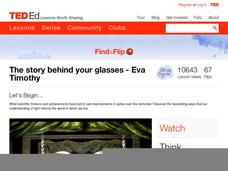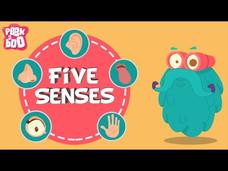Nemours KidsHealth
How the Body Works—Eyes
You might find this video a little silly-ary (ciliary, as in, ciliary muscle). Giant, hat-wearing eyeballs with legs walk around as Chloe and the Nurb discuss different features of this light-collecting organ. Get your class focusing on...
TED-Ed
The Story Behind Your Glasses
Get a new view of vision enhancement with this innovative little film. The history of man's use of lenses and the advancement of optic technology is perused with captivating graphic animation and easy-to-follow narration. Incorporate...
National Academies of Sciences, Engineering, and Medicine
Supporting Emotional Wellbeing in Children: Calming Your Mind
Follow along with a quick video to learn the skill, Mindfulness 5-4-3-2-1. Young learners practice mindfulness to focus on themselves and their surroundings and calm their nerves. A narrator takes viewers through each step.
TED-Ed
What Causes Headaches?
What's the most common type of headache? How do headaches occur? Watch an informative video that details primary and secondary headaches including migraines, cluster headaches, and tension headaches.
Physics Girl
This Crystal Can Split Light Particles
Can photons be split? It appears that way! Observe as one photon becomes two during a video from an informative physics playlist. The resource examines the nature of photons, how the crystals can help increase or decrease the number of...
American Chemical Society
Are Invisibility Cloaks Possible?
What would you do if you could be invisible? It may not be as much of a daydream as you think! Discover the possibility of invisibility through a video from the ACS's Reactions playlist. The resource covers current invisibility...
American Chemical Society
What is the Blackest Black?
Is there really more than one black? Although your crayon box may tell you otherwise, some blacks are, well, blacker than others! Discover the cutting-edge technology at work to produce the blackest black possible with a video from the...
American Chemical Society
Do Carrots Help You See Better?
Does a carrot a day keep the eye doctor away? Junior nutritionists tackle the legend of better eyesight through carrot consumption using a video from the American Chemical Society's Reactions playlist. The narrator exposes the origins of...
Bozeman Science
LS1D - Information Processing
Too much information? How does an organism process all of the sights, sounds, smells, and feelings it receives from its environment? Discover new ideas for presenting Next Generation Science Standard LS1D, Information Processing, in a...
MinutePhysics
Computer Color is Broken
Is your smartphone really doing its best work when it comes to color? The narrator describes technology's lazy approach to recreating colors in an insightful video. Science scholars discover how digital cameras store...
Crash Course
Vision
Your eye cells come in different shapes and serve different functions; rod-shaped cells see shapes and cone-shaped cells see color. Video 18 in the series of 47 teaches all about vision. Scholars see (no pun intended!) how vision works....
Peekaboo Kidz
The Five Senses - The Dr. Binocs Show
Dr. Binocs shows viewers his bag of five senses! He explains how important our eyes, ears, nose, tongue, and skin are, and how they are related to our five senses.
TED-Ed
Could a Blind Eye Regenerate?
Whether it's healing a cut or mending a broken bone, the human body is capable of some pretty amazing repair work, but does it have the power to reverse the blindness caused by genetic diseases? Following along as this...
TED-Ed
The Evolution of the Human Eye
Vision is arguably the most important of the five senses, but exactly how did we come by this amazing ability? Find out with this engaging video on the 500 million year evolution of the human eye.
California Academy of Science
Spiky Sight
Can an organism with no eyes still see? As it turns out for the purple sea urchin, the answer is yes. In a short video, scientists explain why they believe that some sea urchins can use their spikes to visually sense the environment.
TED-Ed
Animation Basics: The Option Illusion of Motion
From creating simple flip books to watching Saturday morning cartoons, we have all experienced the magic of animation. But how is it that a series of still images can be brought to life? It all has to do with the speed at which our brain...
Bill Nye
Bill Nye The Science Guy on The Eyeball
Is your life science class having trouble seeing how the eyeball works? Open their eyes with this little Bill Nye film. Optics concepts involved with vision are revealed. As a unique homework assignment, have individuals watch the...
Khan Academy
Khan Academy: Nervous System Physiology: Sight: Visual Sensory Information
This video looks at the sense of sight and how light hits the photoreceptors in the eye, communicates with the brain, and translates the information into images we can see.
Khan Academy
Khan Academy: The Phototransduction Cascade
This video [9:55] explains photo-transduction cascade which is critical to our sense of vision. By Ronald Sahyouni.


















